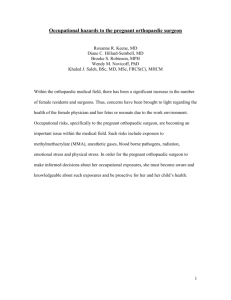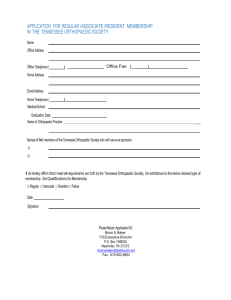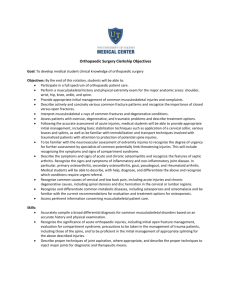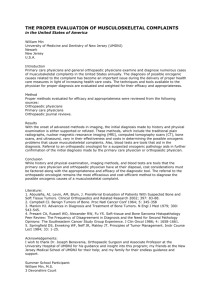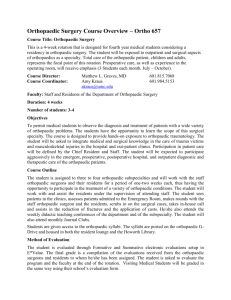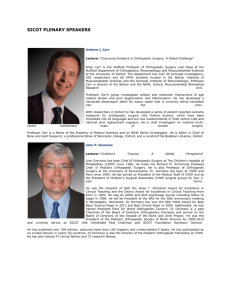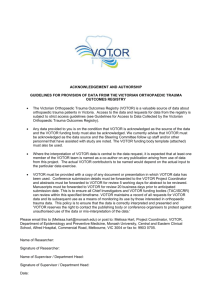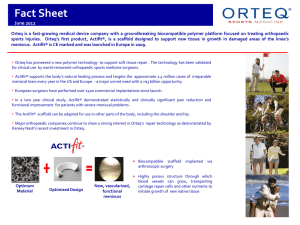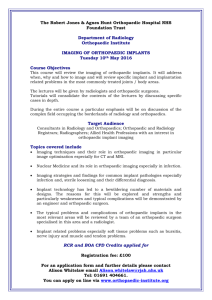Musculoskeletal Workforce Service Forecast
advertisement
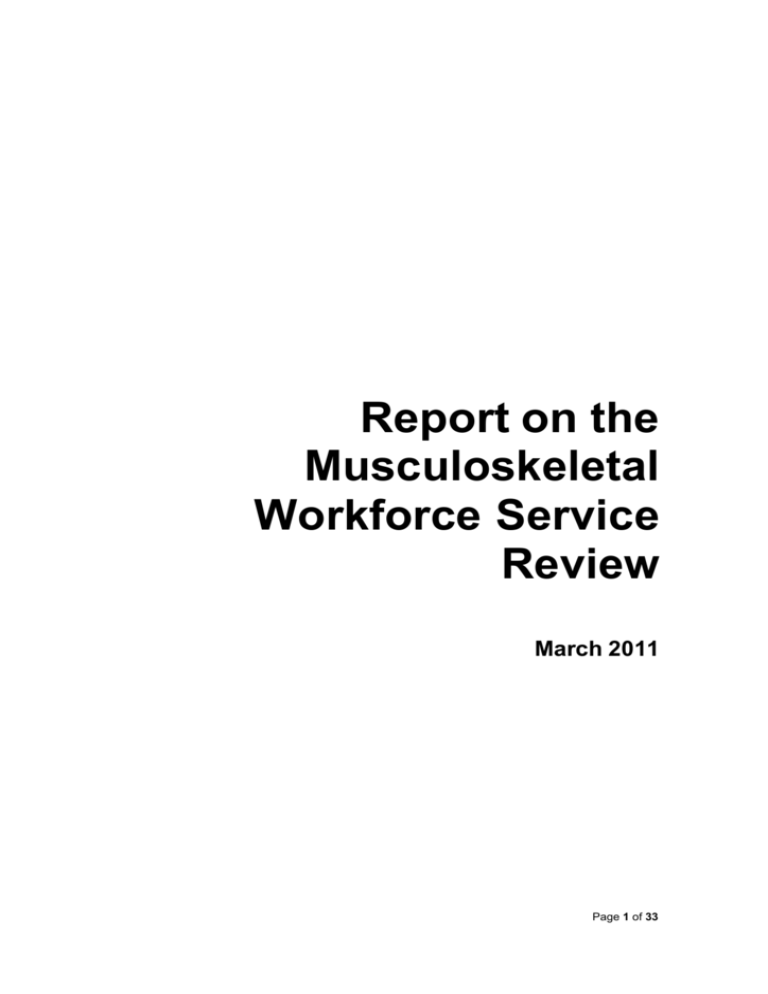
Report on the Musculoskeletal Workforce Service Review March 2011 Page 1 of 33 Musculoskeletal Workforce Service Review Members of the Review Team Lead: Associate Professor Sue Stott Members: Associate Professor Peter Jones, Barnett Bond (GP Liaison Officer), Bryan Thorn, Bill Taine, Kim Miles, Professor Peter McNair (Professor of Physiotherapy). Project Manager: Sue Ineson Analyst: Megan Larken Page 2 of 33 Contents Musculoskeletal Workforce Service Review ........................................................................... 2 Members of the Review Team ........................................................................................... 2 Executive summary ........................................................................................................... 4 1. The Scope of the Problem ............................................................................................. 5 2. Recommendations from the Musculoskeletal Workforce Service Review....................... 6 3. Scenario development ................................................................................................... 9 4. Workforce Implications ................................................................................................ 14 5. Barriers to improved provision of care ......................................................................... 19 6. Relation to HWNZ major themes ................................................................................. 20 7. Forecasting and Modelling ........................................................................................... 21 Figure 1: National Population Change, by Age Group, Relative to 2006 Population .... 22 Figure 2: Orthopaedic First Specialist Events and Inpatient Event Relative Resource Utilisation and Forecast Growth ................................................................................... 23 Figure 3: Average Case weight per Inpatient Discharge, Orthopaedic Inpatient Events 23 Figure 4: Orthopaedic First Specialist Assessment: Forecast Events and Caseweight Equivalents .................................................................................................................. 24 8. Potential for Demonstration Sites................................................................................. 24 Appendix 1 NEW ZEALAND MEDICAL SCHOOL SPECIALIST TRAINING OF DOCTORS IN MUSCULOSKELETAL (MSK) MEDICINE – IS IT ADEQUATE FOR GENERAL PRACTITIONERS? ......................................................................................................... 28 Appendix 2 Annual cost of musculoskeletaldisorders.................................................. 29 Appendix 3 Recommended best practice for follow of patients after a total hip replacement ........................................................................................................................................ 30 Appendix 4 Inpatient and First Specialist Assessment Forecast Caseweights by Age Group .............................................................................................................................. 31 Appendix 5 Forecast Orthopaedic First Specialist Assessment Volumes, by Age Group . 32 References ...................................................................................................................... 33 Executive summary This Report noted that better, sooner more convenient services will be enabled by using the following overarching principles, in turn the recommended changes will assist in improving efficiency and effectiveness in musculoskeletal care and thus decrease costs. Conservative management of musculoskeletal disorders, including chronic musculoskeletal pain, should be a core competency for all general practitioners and physiotherapists. Effective triaging of secondary level DHB referrals by virtual means should be done by the most experienced clinicians including practising orthopaedic surgeons. Physiotherapists and nurse specialist should be up-skilled so they are able to examine and conservatively treat many musculoskeletal disorders. Telemedicine, video-conferencing and other electronic modalities have potential to enhance virtual assessment of patients referred for tertiary level services. An increased emphasis is placed on rehabilitation should start from admission. This approach is summarised in the chart below. Proposed Generic Patient Pathway for Musculoskeletal Conditions Virtual Triage (paper based) Orthopaedic Surgeon Rheumatologist Senior SMO Assessment and referral GP Surgery Post Op Outpatient Assessments Orthopaedic Surgeon Orthopaedic Surgeon FSA FSA Advanced Physiotherapy Practitioner (APP) GP with Treatment/ Management Post Op Outpatient Assessments APP, GPSI Physicians SI Paediatricians SI Nurse Specialists and APPs Special Interest (SI) Page 4 of 33 1. The Scope of the Problem Musculoskeletal disorders are common: 1 in 4 adults in New Zealand are affected by a musculoskeletal disorder 15% of all New Zealanders visit their GPs each year with musculoskeletal complaints. In 2005, 1 in 6 New Zealanders were living with arthritis; by 2020 this is expected to reach 1 in 5, due to demographic aging and increasing obesity. The ongoing cost of musculoskeletal disorders is significant: Musculoskeletal disorders are estimated to cost New Zealand more than $5,570 million per year. The health sector and indirect costs of arthritis alone are estimated at 1.16% of GDP. 21% of sickness and invalid benefit payments are for bone and joint disorders. Ref : C J Bosley and K B Miles, 2009, The Crippling Burden –The Bone and Joint Decade 2000-2010. With the increased number of aged people in the population, there will be an increased number of people who will have “wear and tear” problems, more people with less effective muscle performance and lower physical skill levels, as well as a weakened structural system. These elements will be further affected by obesity, coronary heart disease and osteoporosis. The burden of musculoskeletal disease is expected to increase in next 10-20 years with the aging of population, coupled with increasing obesity. In terms of road trauma despite huge improvements to road safety in New Zealand in the last 35 years, progress has slowed. The number of serious injuries rose between 2004 and 2008. New Zealand’s level of road trauma is high by OECD measures. The level of road death and injury suffered by young people is especially high. The ongoing nature of the cost of road crashes partly explains why they account for almost 30 percent of ACC’s outstanding (i.e. future) claims liability. Page 5 of 33 Source: Safer Journeys: New Zealand's Road Safety Strategy 2010 – 2020. Timely trauma management improves early post-operative outcomes and reduces medical complications. 2. Recommendations from the Musculoskeletal Workforce Service Review Better, sooner more convenient services by the most appropriate person using the following overarching principles will assist in improving sector productivity and thus make savings that will assist the NZ health service maintain quality service provision and meet increased demand. The over arching concept is that the most appropriate person should examine and assess the patient when they are first referred; e.g. clinic-based assessment of a patient by a surgical specialist should only occur when there is a realistic expectation that that patient could require surgery. The specialist surgeon would be involved in triage of the referral; but only see the patient if there is a reasonable possibility of needing surgery 2.1 Improving management of musculoskeletal conditions in primary care will reduce unnecessary referrals for secondary care Conservative management of musculoskeletal disorders, including chronic musculoskeletal pain, should be a core competency for all general practitioners and should continue be emphasised during the training of physiotherapists, given the prevalence and burden of musculoskeletal disease in the community. 2.2 Improved triage of secondary level referrals Paper (virtual) triage of secondary level DHB referrals should be done by the most experienced clinicians (which should include an orthopaedic surgeon, rheumatologists, a GP Liaison officer and advanced physiotherapy practitioners). This triage with expert input will use the information provided to determine whether the patient: Definitely needs to see an orthopaedic surgeon or rheumatologist; Should be first assessed by another member of the team e.g. advanced physiotherapy practitioner or GP with advanced scope of practice in musculoskeletal medicine before accepting the referral for consultant input; or Referral should be declined as inappropriate for the service. Page 6 of 33 Virtual triage of referrals warrants better recognition and support, building such activities specifically into job descriptions may assist. 2.3 Improved assessment and management of non-surgical musculoskeletal conditions accepted for secondary level care in DHBs A recent review of orthopaedic assessment clinics led by physiotherapy ‘clinical leaders’ in Brisbane showed that up to 60% of referrals to an adult orthopaedic surgical clinic can be safely managed by an experienced physiotherapist with consultant support but without direct consultant intervention. The study showed 83-100% satisfaction by consultants, GPs and patients, Ref: Peck (2011.) These results imply that an advanced physiotherapy practitioner model in NZ could provide a first tier level of assessment for many patients currently referred for specialist musculoskeletal medical/surgical review. Advanced physiotherapy practitioners would have the ability to examine, provide initial conservative management and reassurance for many patients with musculoskeletal disorders currently referred to orthopaedic surgeons or rheumatologists. Therefore they can undertake first assessments and early conservative management of many patients with musculoskeletal conditions such as osteoarthritis referred for assessment, with support from an experienced surgeon/physician. Nurse specialist and physiotherapy specialists could do post-operative assessments and follow-ups, either in person, leading clinics alongside the clinician or through virtual clinics, using validated questionnaires and X-ray results at defined intervals. GPs with extended scopes of practice, or physicians/paediatricians with expertise in the non-operative management of musculoskeletal conditions, working in hospital out-patient clinics are another model for assessment of musculoskeletal medical and surgical referrals; as well they could play a valuable role in the education of the referrer; and refer on to consultant surgeons / rheumatologists if necessary. 2.4 Use of enhanced technology for tertiary level referrals Telemedicine, video-conferencing and other electronic modalities have potential for the remote assessment of patients referred for tertiary level services. This could reduce cost of transportation of patients to and from tertiary level centres. Page 7 of 33 2.5 Improved management of acute admissions and musculoskeletal injuries Post-operative adult orthopaedic trauma management benefits from faster access to targeted rehabilitation and, for the elderly, geriatrician input. Rehabilitation should therefore start at admission, not discharge. Increased funding for “semi-elective” trauma theatres to enable better use of theatre time rather than reallocation of non urgent surgery. 2.6 Continued focus on public health measures For example, early interventions to improve fitness and diet in young adults and throughout adulthood including the elderly are needed. In terms of osteoporosis there should be consideration of the use of patient questionnaires, initiated in primary care, for all patients over 30 years of age to identify people at future risk. Under-diagnosis of osteoporosis remains an issue on orthopaedic wards. Ongoing investment in musculoskeletal research is needed to determine the likely burden in the future, as everyone is at risk of developing musculoskeletal conditions. As well, people of all ages should be encouraged to follow a bone and joint healthy lifestyle that is: Maintain physical fitness Maintain an ideal weight Have A balanced diet that meets the recommended daily allowance for calcium and vitamin D Avoid smoking Avoid alcohol misuse. There should also be: Promotion of accident prevention programmes for the avoidance of musculoskeletal injuries Health promotion at the workplace and related to sports activities for the avoidance of abnormal and overuse of the musculoskeletal system Greater public and individual awareness of the problems that relate to the musculoskeletal system Good quality information on what can be done to prevent or effectively manage the conditions and the need for early assessment. These measures will improve the musculoskeletal health of the population. Their modification will also have many other health benefits, as they are risk factors for other conditions, mainly chronic, such as cardiovascular Page 8 of 33 disease, Ref: Woolf A.D. 2.7 Encouragement of patient self care Screening of patients for potential osteoporosis and obesity and other such disorders that will contribute to musculoskeletal injuries occurring/influencing their rehabilitation could be usefully done earlier. These need not be high cost scans or lab analysed tests. Technologies and screening questionnaires as well as simple point of care tests (e.g.: derived from capillary blood) are available for identifying at risk people early. The initiation of wellness plans starting late childhood and extending through into early and middle adulthood is essential. The recommendations to improve prevention and rehabilitation link to similar recommendation in the Ageing Work Service Reviews (WSR). That WSR notes that improved preventative and rehabilitation care, inherent within the ‘healthier ageing’ strategy could reduce the projected increase in admissions to aged-residential care by about 15% over the next 15 years. 3. Scenario development The group focused discussion on five care pathways or scenarios. The enclosed information provides background on each scenario and then details improvements that could be made to the care pathway. The development of improved care pathways led to the recommendations set out in Section 3. 3.1 Chronic musculoskeletal pain referral by General Practitioners (GP) Many GPs feel comfortable managing chronic musculoskeletal pain using the bio-psychosocial model. These patients are best managed by the GP with appropriate investigations and referrals to physiotherapy or other community services. Some GPs who are less familiar with this type of management refer patients into the hospital system through different pathways. For these patients, the pathway can be long and can involve multiple disjointed steps. Thus, for example, of a typical referral pathway for such a patient may look like: GP Neurolo gist Rheumatol ogist Orthopaedic surgeon Specialised pain clinic Anaesthesia model Page 9 of 33 An alternative pathway would be to: Up-skill GPs to manage the case unless referral is necessary Utilise an “expert review group” at the level of the specialist referral to ensure standardised and equitable layered management based on evidence, e.g. cognitive therapy and psychological assistance instead of referral to the usual face to face first specialist assessment (FSA). This is shown diagrammatically as follows: Decline referral: Expert group refer back to GP with advice and assistance to manage the case Refer to expert review group GP Accept referral: review by clinician skilled at distinguishing radicular and neuropathic pain from somatic pain, who can also cover the psychosocial elements that are often present in chronic pain cases, acting as a filter at this stage. 3.2 Osteoarthritis of hip and knee The current standard referral process is from the GP through to orthopaedic surgeon for a face to face visit for example: GP Orthopaedic surgeon (who may not think surgery is required) The following alternative pathways would be more effective for the patient. 3.2.1 A paper based review / virtual triage process based on clinical information and available test and imaging results to identify whether the patient needs to be seen by a specialist at this stage - if not the patient is referred back to the GP with information and advice on how to get specialist follow up if needed at later date. This method is already being used effectively at Auckland DHB using an expert review group of an orthopaedic surgeon with a GP liaison position. The principle embodied in this type of liaison between primary and secondary services could be extended to other specialist areas. The alternative pathway is as follows: GP GP Liaison triage of referral Advice to patient and GP re conservative management & guidelines for re- referral back Review by orthopaedic surgeon if fits criteria Page 10 of 33 Post-operative care and after surgery follow-up would be offered at time intervals according to good practice guidelines for joint replacements as set out in Appendix 4. 3.2.2 Alternatively GP to refer to a physiotherapist led clinic, where an assessment of level of disability according to standardised questionnaires and overall physical assessment would be made and some initial management of the patient provided with advice about weight management, exercise regime etc. The alternative pathway would look like this: GP Physiotherapist led clinic Refer to orthopaedic surgeon only if surgery needed For assessment, advice, early Rx and possibly follow up care Early post operative care via a nurse led clinic under orthopaedic supervision Later post-operative care at a distance via by a questionnaire the patient completes and returns and xray viewing or through nurse practitioner clinic. In many cases the patient would not need to come for immediate orthopaedic review and could then be referred back to GP. Evidence shows that some patients make good improvement in pain and function through exercise programs and other lifestyle changes and therefore may not need surgery at all. If the patient needs a referral to surgeon, this would be made by the physiotherapist. Early post-surgical follow-up would be by surgeon but after one year, follow-ups would be done through a nurse-led clinic, with a face to face consultation only if it was considered necessary by the orthopaedic surgeon. 3.3 Osteoporotic fractures From a hospital perspective the first diagnosis of osteoporosis is often made at the time of the presentation of the fracture. Although fracture management does not always consume major health resources, the follow-up often can. For example there is a decline in functional status following a major hip fracture with up to 40% of patients having a significant decline in function often leading to institutional care with associated costs of that to the system. Currently there is an ad hoc approach to diagnosis of Page 11 of 33 osteoporosis and its ongoing management. Several studies in the USA and Europe indicate that only 20-25% of people presenting with osteoporotic fractures receive any form of assessment or treatment for osteoporosis. There is also evidence that these rates can be improved very significantly through a targeted approach to case finding and intervention, using tools such as FRAX to determine fracture probability and benefit of treatment. Reference: Kanis et al (2008). The current referral pathway is usually as follows: Patient Hospitalised and discharged Fall High probability of being less able to care for self/ leading to institutionalised care There is a role for the frail elderly post-trauma to be reviewed by the geriatric service or an appropriate person under their supervision to maximise medical management in the first few post-operative days. After this early access to rehabilitation is important. The rapid decline in function at this stage and age can have a psychological component and lifestyle elements; these could be addressed with early referral to rehabilitation. An alternative pathway would be: Patient Fall Hospitalised and given active medical management; assessed for osteoporosis risk and need for treatment Early access to rehabilitation and discharge back to self care This work links with the workforce service review on aged care which noted that improved rehabilitation services are central to any managements of future demand on health services by older people. 3.4 Trauma There is clear evidence that trauma management done in a timely fashion improves early post-operative outcomes and reduces medical complications. Page 12 of 33 Most traumas are relatively straight forward and can be managed in provincial, regional and metropolitan hospitals. While minor trauma is seen acutely in the emergency department, ACC funding of the longer term follow-up of trauma-related conditions e.g. meniscal tear, ACL ligament damage, patella dislocation means that the cost to the DHB for managing such conditions is relatively low. A change in ACC funding parameters or a shift to a private insurance model by 2020 could have a significant impact on DHB expenditure in this area and create increased demand for orthopaedic surgical and physiotherapy services through the public system. There will always be a low number of the severely injured who require intensive management and significant resources. It would be useful to define clearly how this is funded, as the cases are proportionately expensive, time consuming, utilise a lot of resources, with ongoing costs. The pathways would be as follows: Trauma Non-complex trauma Hospitalised and managed in local area Complex trauma Hospitalised in Regional or Hub hospital for specialised care Complex trauma is often dealt with by regional hospitals but funding flows are difficult, with DHBs such as ADHB disadvantaged relative to smaller DHBs 3.5 Children’s Orthopaedics A large percentage of referrals to children’s orthopaedics are young children presenting with minor differences in development from their peers, which do not need specialist treatment. This represents about 90% of all referrals into the service. The other 10% has specific orthopaedic conditions that can be managed surgically or complex orthopaedic problems that require management over an extended period. The current pathway is: GP Patient referred and visit specialist service No action usually needed Page 13 of 33 Active first stage triage management by a senior clinician together with a GP liaison is required to minimise over referral sending the referral back to the GP with sufficient information for the GP, patients and their caregivers so they understand why no a specialist appointment has been given. This process can in time change referral practices. Therefore the alternative pathway would be: GP Case goes to expert review team 10% of referrals: Specialist review If no action needed – educative information passed back to GP and caregiver 90% of referrals: Refer for primary assessment in physiotherapy led clinics who would work in conjunction with other medical staff and with an overview from consultant specialists Active second triage system of children who have minor orthopaedic issues through physiotherapy led assessments and non-operative orthopaedic physicians / GPs with extended scope of practice to advise upon active management, interventions and guidance for the GP. Active third level review by orthopaedic surgeon only when orthopaedic surgical diagnosis established. For complex cases with multiple social issues, there would be potential benefits if a multi-disciplinary approach was used across health and other non health organisations such as in the Whanau Ora programme approach where a coordinated multi disciplinary team can deal with the issues of health, education and housing. (This work should to link in with the workforce service review of youth as the benefits of coordinated management of childhood conditions may be easier if a comprehensive approach, a one stop shop, is considered). 4. Workforce Implications 4.1 Conservative management of musculoskeletal disorders should be a core competency for all general practitioners and should continue to be emphasised in the training of physiotherapists. This requires: Greater integration of GP training within orthopaedic and rheumatology clinics in discussion with HWNZ, RNZCGP, NZOA and NZRA. A recent Page 14 of 33 study, via a questionnaire, to assess the adequacy of the Page 15 of 33 undergraduate specialist musculoskeletal (MSK) training in New Zealand medical schools as perceived by trainee General Practitioners. This concluded GP trainees were dissatisfaction with their training in MSK medicine: it is too short, not well distributed throughout the medical course and the content is often inappropriate for primary care It is recommended that there be increased time allocated in the curriculum, more commensurate with the high proportion of patients presenting to GPs with MSK problems in our rapidly aging population, Appendix 2. Increased emphasis on musculoskeletal teaching at undergraduate level, including aspects of rehabilitation and occupational health, because of the number of primary care consultations undertaken for musculoskeletal disorders. An understanding of this area is clearly appropriate for all medical practitioners. Increased CPD opportunities for all GPs in relation to musculoskeletal medicine. Develop a GP workforce with expertise in musculoskeletal medicine. Ongoing education of Primary Care practitioners needs incentives for diplomas, and development of GPs with special interest. (These are used very effectively particularly by ACC in some areas both as a filter for specialist referral, as a means of authorising high tech investigations, and as a way of providing earlier assessment of patients than would be available from a specialist). Active professional development of GPs in relation to working with the secondary sector and improving the quality of referral letters and responding to patients concerns about not seeing a specialist and ways to make re-referrals if concerns continue. The above recommendations link to work of the Bone and Joint Decade Organisation which in New Zealand has in representation from a large number of related MSK disciplines (Osteoporosis NZ, Arthritis NZ, physiotherapists chiropractors, Ministry of Health and ACC).. The continuing aim of this organisation will be to lift the profile of MSK disorders world-wide to benefit sufferers of MSK disorders. The BJD group would be good partners for this project both to promulgate the recommendations and also because they have also noted that up-skilling GPs in musculoskeletal medicine is needed Page 16 of 33 Opportunities for community and DHB physiotherapists to gain further skills and qualifications in advanced musculoskeletal practice to become equivalent of nurse ‘specialists’ or ‘practitioners’. 4.2 Effective triage & assessment of secondary level DHB referrals requires: Expansion and recognition of the value of the expert clinician in the triage role within the DHBs, supported by funding and staffing including expansion of the DHB GP liaison role. The position of GP liaison doctor working between primary and secondary care has shown to be an effective way to achieve change in the GP workforce if there is active support and commitment in the secondary service. (This way of operating does not only apply to musculoskeletal conditions). Develop a workforce of non-operative pediatricians/GPs/physicians interested, and expert, in conservative management of minor musculoskeletal disorders in children or adults but with skills to refer appropriately for expert surgical / rheumatological advice. Integrated access to electronic information across different DHBs, particularly digital radiology, clinician dictations with rationalisation of IT services across different DHBs. Clear agreed regional referral guidelines. 4.3 To enable physiotherapists and nurse specialists to undertake first assessments and early treatments of many patients with musculoskeletal conditions requires: Development and consolidation of advanced scopes of practice for physiotherapists by the Physiotherapy Board and recognized by ACC. Better integration between DHB-funded community physiotherapy services and DHB clinicians. A funding model that incentivises virtual FSAs and use of allied personnel to assess secondary level referrals rather than current model which drives use of consultant specialists to carry out FSAs for patients with minor complaints. Extending musculoskeletal training to clinical nurse specialists, ensuring there is an appropriate career path into this area, developing Page 17 of 33 qualifications with financial and other incentives to undertake this extra work would improve and up skill the musculoskeletal workforce. 4.4 Post-operative orthopaedic management benefits from access to rehabilitation and geriatrician input , this requires: Increased investment to train the rehabilitation physician workforce. Development of a workforce centered on rehabilitation Automatic rather than clinician-generated referral of patients with osteoporotic fractures for appropriate work-up/treatment of osteoporosis. 4.5 Career paths for senior clinicians in the musculoskeletal field, i.e. orthopaedic surgeons and rheumatologists, should be more distinct for example: The current DHB roles are “set in stone” with senior clinicians performing much the same duties as junior consultants. Active career planning and up-skilling for consultant specialists is needed with mentoring of junior consultant into the expert clinician and clinical leader over time. Junior consultants should primarily be involved in first specialist assessments across a wide range of conditions; interventional procedures, including the operating room for surgeons; and registrar training. Junior consultants should be provided with supported exposure to a generalist practice within the specialty for those coming back from overseas training or newly qualified from the local training programme. As clinicians move through their career they should be able to take a more upfront role in clinician leadership, such as mentoring of more junior consultants, administration, provision of more complex niche speciality services and act as knowledge brokers, facilitating translation of research into the health care setting. Conversely, the amount of time spent in routine secondary-level high volume clinical work could be reduced while enabling senior surgeons to continue to provide expeditious high quality surgery, for complex cases and support junior consultants. Page 18 of 33 Professional development and recognition is needed to utilise expert SMOs willing do virtual FSA. 4.6 Other possible workforce issues include: Investigation of the advantages and disadvantages of pain management becoming a Medical Council scope of practice, (currently it is within the anaesthesia scope). Increase in the number of staff with expertise in geriatric management for post-operative medical care within the orthopaedic setting. Increasing the number of doctors trained with expertise in rehabilitation across the sector including tertiary level rehabilitation specialists and GPs with rehabilitation medicine as a special interest. This needs recruitment issues to be addressed and the numbers in training in the rehabilitation field, particularly geriatrics to be increased. 4.7 Development of new roles A useful new area of development could be for a role of non operative orthopaedic pediatricians which would encompass a range of musculoskeletal issues from birth to adulthood. Many conditions presenting in children do not require surgery and may be appropriately managed by a primary care physician with sufficient training in musculoskeletal medicine and the principles of orthopaedics, hence the role of the non-operative paediatric orthopaedist. 5. Barriers to improved provision of care Some of the existing barriers to changes are: The DHB funding model: the completion of FSAs drive funding and are used as a measure of quality – leading to an inefficient use of FSAs and lack of use of more cost effective “virtual referrals” which save surgeon and patient time. Use of team members such as rheumatologists, primary care physicians, physiotherapists, nurses occurs in different ways in different hospitals. More consistent ways of managing referrals and the patient pathway though appropriate models of care need to be put in place across all DHBs so that the right work is done by the right people. Page 19 of 33 Triage of referrals warrants better recognition and support, building such activities specifically into job descriptions may assist and provision of appropriate aids for triage such as IT, digital radiology etc would facilitate this service. Junior registrars are used to do “routine work” but they do not have the experience, so their decision making is conservative and this drives the continuation of routine work, such as un-necessary follow-up and costly investigations and imaging. Lack of ability of GPs to obtain appropriate scans prior to referral – better triage processes should allow such scans to occur so referrals are better “worked up” before the patient enters the secondary system or managed without having to refer to secondary care. Psychological barriers: the fear of missing something leads to overinvestigation and to too many FSAs. Concern about complaints leads a defensive approach to medicine. An improvement in ability to fully understand the overall disability a patient may have, taking into account medical, social, psychosocial and other factors may need enhancement of orthopaedic surgeons’ skills and improvement in scoring tools. The training model from medical school onwards is based on competition for places and this does not prepare doctors for working in a team. Lack of sharing of information / patients across the specialists and across the primary and secondary / tertiary divide due to barriers in IT. 6. Relation to HWNZ major themes The following section outlines how the review findings relate to major themes the government is focusing on. 6.1 Move to hub and spoke service configurations In smaller centres triage services and specialist clinics could be supported from a hub with experts able to advise clinicians. 6.2 Regionalisation of services Complex trauma could be more effectively dealt with by one hospital serving the whole region and then investment could be made into Page 20 of 33 separation of elective and trauma theatres to enable better use of theatre time. While technology links between hospitals are steadily improving, clear agreed regional referral guidelines would enhance the use of technology. This is illustrated well in the field of spinal conditions in the South Island. Christchurch provides a rostered spinal injury service whereas it is understood that Auckland does not. Without agreed pathways the technology will not be as useful. 6.3 Moving hospital services into the community Increase management of musculoskeletal conditions in primary care e.g. by GPs, physiotherapist and nurse specialists will assist in moving secondary services into the community and assist the move to self management of some conditions by patients. 6.4 Better, sooner more convenient services Better, sooner more convenient services can be achieved by using the most appropriate person to deliver the service required. For example “virtual” FSA by experienced clinicians and increased involvement of GP, physiotherapists and nurse practitioners in musculoskeletal care as set out in the recommendation Section 3. This in turn will make savings that will assist the New Zealand health service maintain quality service provision while meeting increased demand. Development of non-operative roles ‘orthopaedic physicians’ to assess and manage minor orthopedic conditions requiring conservative management. 6.5 Impact of new technology Telemedicine, video-conferencing and other electronic modalities have future potential to enhance virtual assessment of patients referred for tertiary level services in nurse run or physiotherapist-led clinics: Use of telemedicine, and video as a diagnosis tool at a “virtual assessment” and use of electronic communication between primary and secondary carer would increase effectiveness of both groups of practitioners. For example, rather than paying for the patient to come to the specialist, telemedicine could bring the specialist to the patient (this is particularly so for children’s orthopaedics, with referrals from around the country).This requires better access to technology in peripheral hospitals and agreement on referral guidelines. Page 20 of33 Wider use of electronic communication would be more efficient: Provision of an “Ask the Specialist” service through electronic communication, with allocated office hours for face to face or electronic mail with GPs would be efficient and also provide GPs with educational feedback. Orthopedics is well suited to this method of consultation as much of the initial decision making is based on X-rays, which are now available electronically. However the current funding model does not support such activities. 6.6 Improved productivity (to deliver same quality and service levels in 2020) Ensuring the most appropriate person delivers the service at every steps of the patient pathway as set out in the recommendations in section 3. A new approach to FSA and use of virtual assessment by experienced clinicians. Better use of the time of SMOs and increased management of care by GPs, and physiotherapist and nurse specialist and better use of the wider allied health workforce. Better use of theatres for example running scheduled trauma theatre lists into the evening staffed at an appropriate level. 7. Forecasting and Modelling Bossley and Miles’ ‘The Crippling Burden’ (2009) provides a summary of various studies to quantify the burden of musculoskeletal disorders on New Zealand society. This study completed in 2009 noted that the burden of musculoskeletal disease was up to $5 571 million per annum as detailed in Appendix 3. Because many musculoskeletal conditions affect the elderly, there will be increasing numbers affected people as the population ages as shown in Figure 1 below. Page 21 of33 Figure 1: National Population Change, by Age Group, Relative to 2006 Population 140% 2010 2016 2020 2026 120% Change Relative to 2006 100% 80% 60% 40% 20% 0% 0 1-4 5-9 10-14 15-19 20-24 25-29 30-34 35-39 40-44 45-49 50-54 55-59 60-64 65-69 70-74 75-79 80-84 85-89 90+ -20% Age Group In 2003 the New Zealand Orthopaedic Association projected the impact of the aging population on musculoskeletal conditions in 2015, 2030 and 2051, using Statistics New Zealand population projections and data on specific musculoskeletal conditions. This analysis predicted that fracture injuries would increase in 2015, decrease in 2030 then increase again to 2051 – an overall increase of 8.3%. Other conditions are all predicted to increase in successive years. Musculoskeletal operations will increase by over 30 percent during the next 50 years. In 2005, Access Economics did projections on the prevalence of arthritis and estimated that it would increase to 19.2 percent of the New Zealand population by 2020 – an increase of around 1.2 percent per annum since 2005. (Access Economics, 2005). HWNZ has forecast future orthopaedic inpatient and first specialist assessment volumes, both in case weighted discharges (which are a measure of hospital resource utilisation), and number of outpatient events and inpatient discharges. Figure 2 presents the relative resources used in delivering orthopaedic inpatient and first specialist assessment volumes respectively and their forecast growth by patient age group out to 2026. Page 22 of33 Figure 2: Orthopaedic First Specialist Events and Inpatient Event Relative Resource Utilisation and Forecast Growth 7000 2006 2010 2016 2020 2026 6000 5000 4000 3000 2000 1000 00-04 05-09 10-14 15-19 20-24 25-29 30-34 35-39 40-44 45-49 50-54 55-59 60-64 65-69 70-74 75-79 80-84 85-89 90-94 95-100 100+ 00-04 05-09 10-14 15-19 20-24 25-29 30-34 35-39 40-44 45-49 50-54 55-59 60-64 65-69 70-74 75-79 80-84 85-89 90-94 95-100 100+ 0 Inpatient Caseweighted Discharges First Specialist Attendances Caseweight Equivalents Figure 3 below, the average case weight per inpatient event, provides a measure of orthopaedic surgery complexity. As patients age, their complexity of their orthopaedic care also increases. 3.50 3.00 2.50 2.00 1.50 1.00 0.50 100+ 95-100 90-94 85-89 80-84 75-79 70-74 65-69 60-64 55-59 50-54 45-49 40-44 35-39 30-34 25-29 20-24 15-19 10-14 05-09 0.00 00-04 Average Caseweight Per Inpatient Discharge Figure 3: Average Case weight per Inpatient Discharge, Orthopaedic Inpatient Events Age Band Page 23 of33 It is the culmination of both an age related increase in complexity and the population growth contained in figure 1 above, that produces the forecast increase in orthopaedic resource demands contained in figure 2. Figure 4: Orthopaedic First Specialist Assessment: Forecast Events and Caseweight Equivalents 1200 1000 2006 2010 2016 2020 2026 800 600 400 200 00-04 05-09 10-14 15-19 20-24 25-29 30-34 35-39 40-44 45-49 50-54 55-59 60-64 65-69 70-74 75-79 80-84 85-89 90-94 95-100 100+ 00-04 05-09 10-14 15-19 20-24 25-29 30-34 35-39 40-44 45-49 50-54 55-59 60-64 65-69 70-74 75-79 80-84 85-89 90-94 95-100 100+ 0 WIES Caseweight Equivalents Number of Events Considering first specialist assessments alone, figure 4 above presents a forecasted increase in number of outpatient orthopaedic events for all age groups 50 and over. Again, like inpatient events, the highest relative growth will manifest in the elderly. The data for on which Figures 2 and 4 have been built is detailed in Appendix 4 and 5. 8. Potential for Demonstration Sites An application has been made to the innovation demonstration fund for a six-month position of “non-operative” orthopaedic physician role at Starship Children’s Hospital. The objectives of this are: 1. To reduce waiting time for non-urgent general Paediatric Orthopaedic Surgical FSAs (i.e. First Specialist Appointments: B and C priorities). The projected impact will be a reduction in reducing clinic waiting times from 13 + months to less than 3 months. Page 24 of33 2. To provide effective early triage of referrals into operative and nonoperative categories within a time frame of 10 days. 3. To provide responsive and effective service for the 80% of children referred to the orthopaedic department who do not have a surgical problem but where families and GPs require reassurance, request musculoskeletal assessment and provision of non-operative management strategies. This will be done by: 1. Trial of a six-month appointment of a “non-operative orthopaedic physician” to the Orthopaedic Department at Starship Children’s Hospital. This person has completed training as a general paediatrician and also a fellowship in non-operative orthopaedic practice in the USA and will be taking up a position in the United States in February 2012. 2. This person will work with the senior clinicians in the orthopaedic department to: triage all GP referrals and patients on the current clinic W/L into (a) requires primary review by an orthopaedic surgeon (b) does not require primary review by an orthopaedic surgeon. carry out first appointment clinics to assess new referrals of patients assessed as not needing urgent orthopaedic management with outcome being one of the following; return to GP with advice; refer on to appropriate paediatric medical service if problem is medical, not orthopaedic ; or arrange appropriate investigation/s, trial of nonoperative management prior to definitive orthopaedic surgical review. The rationale for the demonstration site is that: 1. Children’s orthopaedics at Starship Hospital is a service that has a high volume of referrals from primary care (2000 +per year), due to GP concerns about ‘missing’ diagnoses; GP unfamiliarity with the musculoskeletal assessment of the young child; and parental concerns about their child’s musculoskeletal development compared to other children. GPs are reluctant to manage in general practice and prefer to refer to orthopaedics. 2. Paediatric orthopaedics has had active triage processes in place for the last three years and declines 30% of referrals. However, despite this, there is still a considerable backlog of new patients to be seen with a clinic waiting time of more than 13 months. Page 25 of33 3. The majority of these lower priority referrals will never need surgical intervention. As a result, the conversion rate from FSA (first specialist appointment) to surgical waiting list is less than 5% of new patients seen in clinic. 4. Seeing large numbers of children who have minor orthopaedic conditions, or that do not have orthopaedic surgical disorders, is an inefficient and expensive use of orthopaedic surgeon time, given the time and cost required to train a surgeon. The cost to the DHB of managing a large and angry waiting list of children/families is also substantive (and often hidden). 5. Thus this proposal seeks to address the poor use of orthopaedic surgeon time (principle one) and provide value for money (principle three) by improving the efficiency and effectiveness of managing GP non-operative orthopaedic referrals through other members of the medical workforce. 6. For this project this will be achieved through hiring a non-operative orthopaedic physician, i.e. a paediatrician with extended scope of practice to non-operative orthopaedics; but this acts as proof in principle for similar work to be done by GPs with advanced scope of practice, advanced physiotherapy practitioners etc Outcome expected 1. More appropriate use of orthopaedic surgeon time to focus on better outcomes for those orthopaedic patients requiring surgery, rather than those who will never require surgery. 2. Speedier and more efficient review of children with minor orthopaedic issues, alleviating parental stress and reducing the non-productive workload carried by DHB staff who have to create and manage the 600+ clinic waiting list as well as the large number of phone calls and communications from angry parents and GPs. Maintaining a large and lengthy waiting list is costly for the DHB, leads to errors with inadvertent dropping of names off the list, and is de-motivating for staff and patient. 3. Better communication with referrers, prompt feedback on referrals, advice given electronically. Possible benefits for the wider health sector and workforce The idea is applicable to adult and paediatric high-volume surgical settings, where referrers are unclear of the indication for surgery and then refer ‘just in case’. 1. Some models already exist, e.g. cardiologists work closely with cardiothoracic surgeons, but higher volume surgical and orthopaedic services do not necessarily require a highly skilled physician with advanced training. Page 26 of33 2. Thus the idea can act as a proof in principle for a number of members of the medical workforce, for example for GPs with advanced scopes of practice working within a surgical department to carry out primary review of secondary level referrals; general physicians / paediatricians with an interest in musculoskeletal disorders or advanced physiotherapy practitioners in the orthopaedic field. 3. The model is consistent with a team approach to musculoskeletal referrals (rather than a departmental ‘silo’ approach) and unlocks the potential of the orthopaedic workforce to focus on those children who have surgical conditions. 4. A similar idea is applicable to adult orthopaedics but where model might be better directed to physicians with an orthopaedic interest or advanced physiotherapy practitioners. Page 27 of33 Appendix 1 NEW ZEALAND MEDICAL SCHOOL SPECIALIST TRAINING OF DOCTORS IN MUSCULOSKELETAL (MSK) MEDICINE – IS IT ADEQUATE FOR GENERAL PRACTITIONERS? AUTHOR: Megan Brown SUPERVISOR(S): Mr. Russell Tregonning, Mr. Chris Bossley SPONSOR: Wellington Surgical Research Trust, Phil & Teds Ltd and The University of Otago Matched Funding Summer Scholarship LOCATION: Department of Surgery and Anaesthesia, University of Otago, Wellington, New Zealand DATE: January 2010 Abstract: Aims: This project aims to assess the adequacy of the undergraduate specialist musculoskeletal (MSK) training in New Zealand medical schools as perceived by trainee General Practitioners (GPs). Methods: A questionnaire was formulated after consultation with experts in MSK medicine and Biostatistics. Participants from the Royal New Zealand College of General Practitioners (RNZCGP) were invited to participate via an email which included a link to the survey on the internet. Collected data was downloaded into Excel and analysed using the Epi Info analysis package. Results: The response rate of this survey was 33.8%. Nineteen people (25.3%) had a MSK attachment in Year 4 only, while twenty people (26.7%) had a MSK attachment in Year 5 only. Eighty one percent of participants completed a Trainee Intern clinical attachment in a MSK-orientated specialty. Forty seven percent of respondents thought that their MSK training was far too short. Preparation in MSK medicine was consistently thought to be at a worse level than three other specialist areas. Respondents felt consistently under prepared in six out of the nine essential MSK skills surveyed. Suggestions for improving MSK training included spreading the training over all three clinical years (29.7%), increasing time in MSK training supervised by General Practitioners (69.1%) and involving other health care professionals. Conclusion: GP trainees report dissatisfaction with their training in MSK medicine: it is too short, not well distributed throughout the medical course and the content is often inappropriate for primary care It is recommended that there be increased time allocated in the curriculum, more commensurate with the high proportion of patients presenting to GPs with MSK problems in our rapidly aging population. Page 28 of33 Appendix 2 Annual cost of musculoskeletal disorders. Summary of the Burden Annual costs of musculoskeletal disorders in New Zealand Disorders/Benefits paid Annual cost Approx number of ($million) people aff..cted annually Arthritis 2,089 497,000 Osteoporosis (diagnosed) 1,133 123,000 Injuries(ACC) 1,556 1,264,000 Sickness benefits 320 30,850 PhysiotheraPI' (ACC) 127 34,000 visits Chronic pain N/A 528,100 Joint "'placement(hlp & knee) 191 11,575 Pharmaceuticals (arthritsi,osteopoiOSis) 61 GPvisits 26 Pathology (arthritis) 19 Imaging( rthr1tis) 49 TOTAL: $ ,571 million 441,504 Note: 1. The above figures havebeen taken from the documents listE!d-below,but there willbe overl"aps between different categoriesof musculoskeletal disorder- eg.arthritis patients having physiotherapy treatments. 2. There will also be costs In patients having Imaging and pathology testsfor musculoskeletal disor:ders othec than arthritis. As these costs are not available,the.aboveliguresare likely to be underestimated. 3. We have ma<:te no attempt.to assess the psychosocial costs associated with musculoskeletal disorders, excQPtwhere thehave been independently quantified. 4. DALY's (disability adjusted life years, i.e,years of productivelifelosfdue to disability) and QALY's (q uality adjusted life years,IM., a measure of disease burden) have not been ud Jn this stu y. Page 29 of33 Appendix 3 Recommended best practice for follow of patients after a total hip replacement For best practice patients should be followed up clinically and radiologically in the longer term. For uncomplicated hip replacements follow ups should occur at 6 weeks and one year with longer follow up at two yearly intervals with functional assessment and AP and lateral x ray. NZOA Best Practice Hip replacement guidelines http://www.nzoa.org.nz/Publications%20Guidelines%20and%20Reports.php Page 30 of 33 Appendix 4 Inpatient and First Specialist Assessment Forecast Caseweights by Age Group First Specialist Attendances Caseweight Equivalents Inpatient Caseweighted Discharges Data Age Group 00-04 05-09 10-14 15-19 20-24 25-29 30-34 35-39 40-44 45-49 50-54 55-59 60-64 65-69 70-74 75-79 80-84 85-89 90-94 95-100 100+ 00-04 05-09 10-14 15-19 20-24 25-29 30-34 35-39 40-44 45-49 50-54 55-59 60-64 65-69 70-74 75-79 80-84 85-89 90-94 95-100 100+ 2006 274 458 606 1,037 994 694 850 881 1,356 1,060 1,488 1,842 1,941 2,403 2,940 3,227 2,983 1,981 955 290 244 118 97 179 166 122 84 83 85 89 93 92 91 86 84 80 77 56 22 7 2 3 2010 300 455 569 1,064 1,020 729 769 856 1,295 1,099 1,635 1,878 2,442 2,721 3,259 3,231 3,220 2,481 1,157 355 190 130 96 169 172 127 86 75 82 84 97 101 93 108 96 89 78 61 28 9 2 2 2016 282 500 559 975 1,062 766 802 752 1,223 1,033 1,688 2,147 2,621 3,576 3,975 3,820 3,354 2,947 1,668 547 430 122 107 168 158 133 92 77 72 79 90 104 107 116 125 109 92 64 33 12 3 4 2020 273 473 603 961 1,002 783 830 780 1,114 998 1,596 2,211 2,864 3,653 4,983 4,393 3,712 3,104 1,942 772 558 117 101 183 156 125 95 79 73 71 86 98 110 127 128 137 106 71 35 14 5 7 2026 265 450 567 1,042 986 705 860 825 1,165 881 1,502 2,067 2,942 4,193 5,421 5,780 4,722 3,924 2,294 940 903 111 96 172 172 123 86 83 77 72 76 91 102 131 147 148 139 90 45 17 6 11 Relative Change 2026-2006 -3% -2% -7% 1% -1% 2% 1% -6% -14% -17% 1% 12% 52% 75% 84% 79% 58% 98% 140% 224% 271% -6% -1% -4% 3% 0% 2% 0% -9% -18% -19% 0% 11% 52% 75% 86% 81% 60% 102% 143% 233% 249% Page 31 of 33 Appendix 5 Forecast Orthopaedic First Specialist Assessment Volumes, by Age Group Age Group 00-04 05-09 10-14 15-19 20-24 25-29 30-34 35-39 40-44 45-49 50-54 55-59 60-64 65-69 70-74 75-79 80-84 85-89 90-94 95-100 100+ 2006 646 607 829 843 704 587 625 602 669 650 653 649 615 605 548 518 427 204 84 19 43 2010 708 604 783 870 731 605 568 583 639 676 719 663 776 685 610 519 460 257 102 24 28 2016 665 667 772 796 757 645 582 513 599 638 746 762 837 900 747 615 478 305 147 38 55 2020 2026 643 630 840 784 705 664 601 526 544 615 710 789 917 920 937 707 531 323 170 53 89 624 599 787 857 689 598 627 556 560 543 667 742 955 1059 1021 931 678 411 202 66 151 Relative Change 2026-2006 -3% -1% -5% 2% -2% 2% 0% -8% -16% -16% 2% 14% 55% 75% 86% 79% 59% 102% 142% 240% 251% Page 32 of 33 References C J Bossley and K B Miles, (2009), The Crippling Burden –The Bone and Joint Decade 2000-2010. Safer Journeys: New Zealand's Road Safety Strategy 2010 – 2020. J.A. Kanis et al (2008) FRAX and the assessment of fracture probability in men and women from the United Kingdom Osteoporosis International Volume 19 No 4 A D Woolf and The European Union of Medical Specialists Section of Board of Rheumatology 2006; Healthcare services for those with musculoskeletal conditions: a rheumatology service. Recommendations of the European Union of Medical Specialists Section of Rheumatology/ European Board of Rheumatology 2006 66; 293-301; originally published online 7 Dec 2006; S Peck 2010; Orthopaedic assessment Clinics- Executive Summary of Brisbane Observership report. M Brown (2010) New Zealand medical school specialist training of doctors in musculoskeletal (msk) medicine –is it adequate for general practitioners? A 2009/2010 summer studentship project. New Zealand Orthopaedic Association, July 2003, The Aging of New Zealand – An epidemic with major impact on musculo-skeletal disease. Report can be found on: http://www.boneandjointdecade.org/Default.aspx?contId=310 Page 33 of 33
